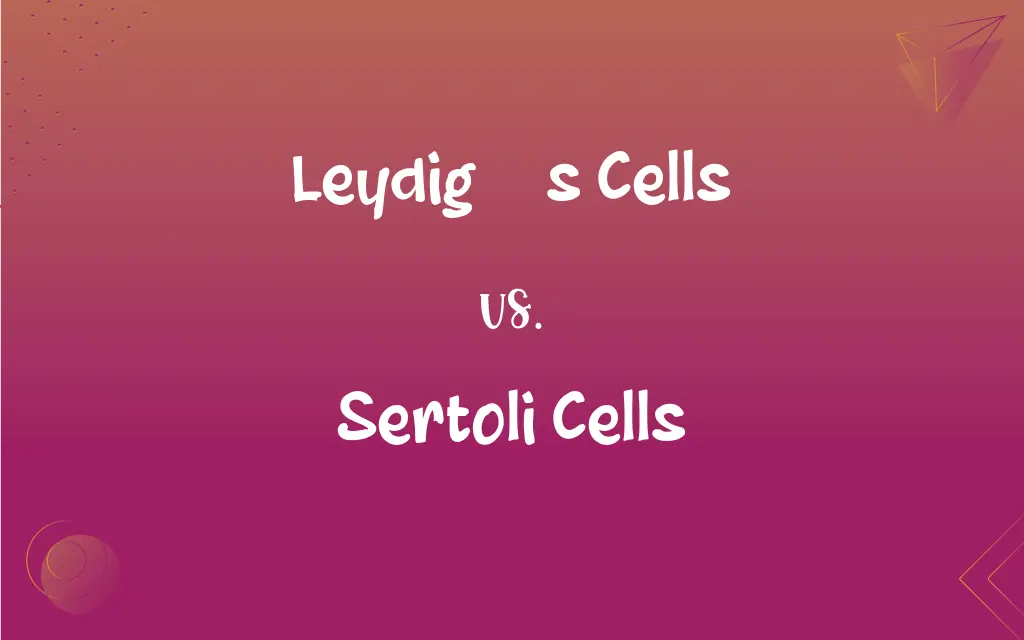Leydig’s Cells vs. Sertoli Cells: What's the Difference?
Edited by Aimie Carlson || By Harlon Moss || Updated on October 4, 2023
Leydig's cells produce testosterone in the testes, while Sertoli cells support and nourish developing sperm cells.

Key Differences
Leydig's cells are specialized cells situated in the interstitial tissue of the testes. Their primary function is to produce and release testosterone. In contrast, Sertoli cells are found within the seminiferous tubules of the testes and play a crucial role in spermatogenesis, the process of sperm cell development.
While Leydig's cells are primarily responsible for the hormonal aspect of male reproductive health by synthesizing testosterone, Sertoli cells ensure that the structural and nutritional needs of developing sperm are met. They create a barrier, known as the blood-testis barrier, protecting sperm from the immune system.
The functionality of Leydig's cells is heavily influenced by luteinizing hormone (LH), a hormone from the anterior pituitary gland. When LH binds to Leydig's cells, it stimulates testosterone production. On the other hand, Sertoli cells are regulated by follicle-stimulating hormone (FSH), which promotes the maturation of sperm.
It's important to understand the interplay between Leydig's cells and Sertoli cells for the effective functioning of the male reproductive system. While Leydig's cells maintain the required levels of testosterone necessary for male characteristics and fertility, Sertoli cells ensure the sperm produced are mature and viable for fertilization.
Any dysfunction in Leydig's cells could lead to reduced testosterone levels, affecting male fertility. Similarly, malfunctioning Sertoli cells can compromise the quality and quantity of sperm, leading to fertility issues.
ADVERTISEMENT
Comparison Chart
Location
Interstitial tissue of the testes
Seminiferous tubules of the testes
Primary Function
Production of testosterone
Support and nourishment of developing sperm cells
Hormonal Regulation
Regulated by luteinizing hormone (LH)
Regulated by follicle-stimulating hormone (FSH)
Relationship to Sperm
Does not directly interact with sperm
Directly involved in sperm development
Potential Dysfunction
Reduced testosterone production
Reduced quality or quantity of sperm
ADVERTISEMENT
Leydig’s Cells and Sertoli Cells Definitions
Leydig’s Cells
Cells that contribute to male fertility by producing testosterone.
Healthy Leydig’s cells ensure optimal testosterone production.
Sertoli Cells
Cells that nourish developing sperm cells in the testes.
Sertoli cells provide a protective environment for sperm maturation.
Leydig’s Cells
Interstitial cells crucial for male reproductive health.
Leydig’s cells, when stimulated by LH, release testosterone.
Sertoli Cells
Cells that create the blood-testis barrier for sperm protection.
The immune system is kept away from sperm by the barrier formed by Sertoli cells.
Leydig’s Cells
Endocrine cells in the testicles that secrete hormones.
Testosterone levels are maintained by active Leydig’s cells.
Sertoli Cells
Support cells ensuring the quality and quantity of sperm.
Fertility issues might arise if Sertoli cells aren't functioning properly.
Leydig’s Cells
Cells that produce testosterone in the testes.
The decrease in male hormones can be attributed to non-functional Leydig’s cells.
Sertoli Cells
Cells regulated by FSH to promote sperm maturation.
For optimal sperm development, functional Sertoli cells are crucial.
Leydig’s Cells
Testicular cells responsible for male secondary characteristics.
A dysfunction in Leydig’s cells can lead to reduced masculine traits.
Sertoli Cells
Testicular cells involved in spermatogenesis.
The sperm's maturation process is closely monitored by Sertoli cells.
FAQs
Where are Leydig’s cells located in the testes?
Leydig’s cells are situated in the interstitial tissue.
What is the primary function of Sertoli cells?
Sertoli cells nourish and support developing sperm cells.
Which cells produce testosterone?
Leydig’s cells produce testosterone.
What hormone influences Leydig’s cells?
Luteinizing hormone (LH) influences Leydig’s cells.
What would happen if Sertoli cells were removed from the testes?
Sperm maturation and protection would be compromised, leading to fertility issues.
How do Sertoli cells interact with sperm?
Sertoli cells nourish and protect developing sperm.
Can a male have normal testosterone levels but issues with sperm development?
Yes, if Sertoli cells are dysfunctional while Leydig’s cells remain functional.
Why are Leydig’s cells essential for male reproductive health?
They produce testosterone, vital for male traits and fertility.
Are Sertoli cells involved in hormone production?
No, Sertoli cells primarily support spermatogenesis.
Is testosterone production solely dependent on Leydig’s cells?
Yes, in the testes, Leydig’s cells are the primary producers of testosterone.
How do Sertoli cells protect sperm from the immune system?
They create a blood-testis barrier.
What happens if Leydig’s cells don't produce enough testosterone?
It can affect male fertility.
Are Leydig’s cells influenced by any other hormones besides LH?
LH is the primary hormone, but other factors can indirectly influence their function.
Can a dysfunction in Leydig’s cells affect male fertility?
Yes, dysfunction can reduce testosterone levels, affecting fertility.
What role does FSH play with Sertoli cells?
FSH promotes sperm maturation by regulating Sertoli cells.
How do Sertoli cells contribute to male fertility?
They ensure the sperm produced are mature and viable.
Why is testosterone production essential in males?
It's necessary for male characteristics and fertility, primarily produced by Leydig’s cells.
Can an individual have functioning Leydig’s cells but malfunctioning Sertoli cells?
Yes, each cell type can function independently but both are crucial for fertility.
How do Sertoli cells assist in the life cycle of sperm?
They provide nutrients and a conducive environment for sperm development.
Do Sertoli cells have any role in testosterone production?
No, testosterone production is the primary function of Leydig’s cells.
About Author
Written by
Harlon MossHarlon is a seasoned quality moderator and accomplished content writer for Difference Wiki. An alumnus of the prestigious University of California, he earned his degree in Computer Science. Leveraging his academic background, Harlon brings a meticulous and informed perspective to his work, ensuring content accuracy and excellence.
Edited by
Aimie CarlsonAimie Carlson, holding a master's degree in English literature, is a fervent English language enthusiast. She lends her writing talents to Difference Wiki, a prominent website that specializes in comparisons, offering readers insightful analyses that both captivate and inform.































































